How Much Does Content Marketing Cost In 2025?
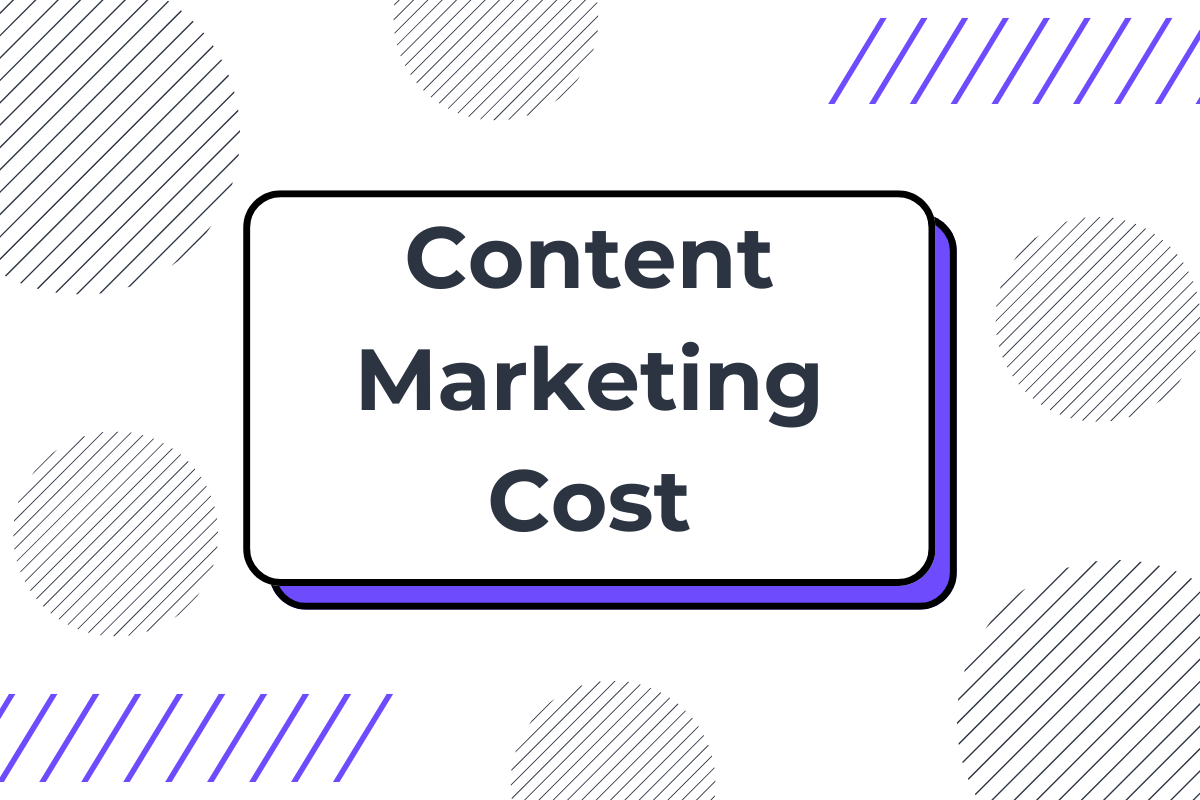
You stare at your marketing budget spreadsheet.
The numbers blur together.
Content marketing seems crucial, but the costs? They're all over the place.
Truth is, you're not alone.
According to the Content Marketing Institute, 56% of B2B marketers are struggling to figure out the ROI of their content marketing efforts.
Some agencies quote $500 per blog post. Others want $5,000.
And those monthly retainers? They range from $2,000 to $20,000. It's enough to make your head spin.
Let's fix that. We'll break down exactly what content marketing should cost in 2025—from blog posts to social media campaigns. So let’s get straight into it.
Content Marketing Costs Breakdown In 2025
On average, content marketing costs between $2000 to $15,000 per month. This includes blog posts, social media, video content, and email marketing.
A standard blog post costs between $150 to $600. Social media management runs $1,000 to $5,000 per month. Video content? That's $500 to $3,000 per video. Knowing these ranges helps you spot fair deals and avoid overpaying.
Current Market Rates
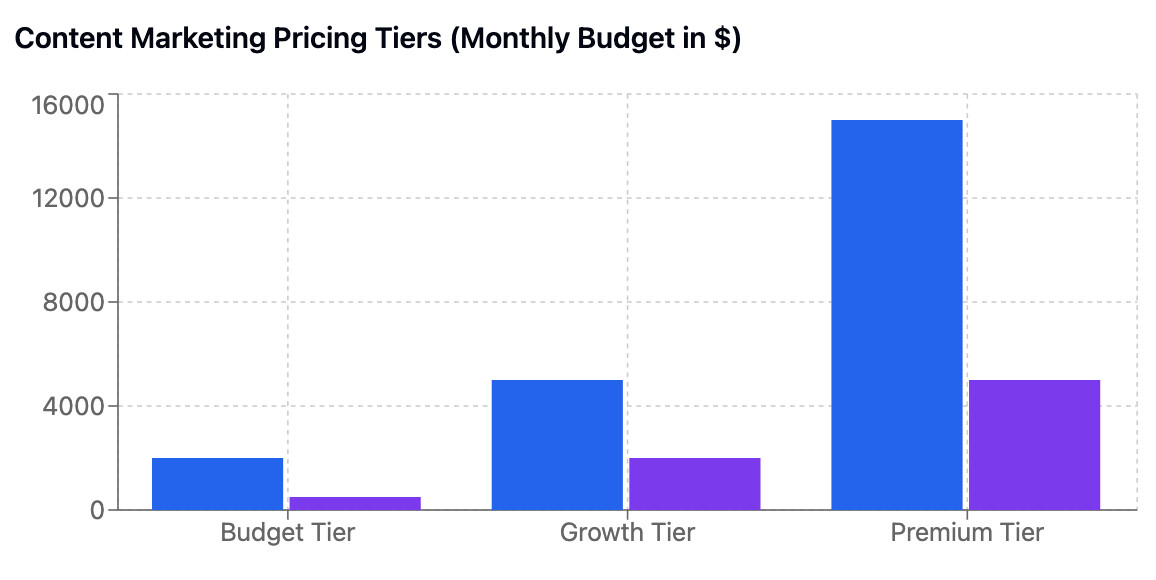
The content marketing can be broken down into three main pricing tiers:
Budget Tier: $500-2,000/month
-
Basic blog posts (2-4 per month)
-
Social media posts (12-15 per month)
-
Monthly analytics report
Growth Tier: $2,000-5,000/month
-
Premium blog posts (4-8 per month)
-
Daily social media management
-
Email newsletters
-
Basic video content
-
Quarterly strategy updates
Premium Tier: $5,000-15,000/month
-
Advanced content strategy
-
Daily multi-platform content
-
Custom videos and graphics
-
Influencer partnerships
-
Monthly strategy meetings
Factors Affecting Pricing
Your final content marketing costs depend on:
Content Quality Level
-
Basic: $0.10-0.15 per word
-
Professional: $0.15-0.30 per word
-
Expert/Technical: $0.30-1.00+ per word
Content Types Required
-
Written content: 30% of budget
-
Visual content: 25% of budget
-
Video content: 35% of budget
-
Distribution: 10% of budget
Industry Complexity
-
General topics: Base rate
-
Technical topics: +25-50%
-
Specialized industries: +50-100%
Cost Components Breakdown
Here's where your content marketing dollars typically go:
Strategy Development: 15-20%
-
Market research
-
Competitor analysis
-
Content calendar
-
KPI setting
Content Creation: 45-50%
-
Writing
-
Editing
-
Design
-
Video production
Distribution & Promotion: 20-25%
-
Email marketing
-
Paid promotion
-
SEO optimization
Analysis & Optimization: 10-15%
-
Performance tracking
-
A/B testing
-
Content updates
-
ROI reporting
Now, let’s learn more about the factors that affect content marketing costs.
Factors Affecting Content Marketing Pricing
Your content marketing costs will vary based on six core factors. Understanding these will help you budget better.
Industry Complexity
Your industry directly impacts content costs.
A blog post about pet care might cost $200.
But the same post for a research-based health related topic? That's $500-600 per piece.
Medical content costs 40% more than general content. Financial content sees a 35% more cost.
Writers in these industries often need deep industry knowledge to create accurate content in these fields, and as a result costs are typically higher.
Content Depth And Research
Surface-level content costs less. But it also performs worse in the long run.
A basic 500-word blog post costs $100-200. A detailed 2,000-word guide with custom images? That's $600-1,000.
Research-heavy content adds more costs. You'll pay extra for:
-
Market research data: $200-500 per report
-
Expert interviews: $150-300 per interview
-
Custom surveys: $500-2,000 per survey
-
Data visualization: $100-300 per graphic
But it will rank consistently and convert better.
Content Format And Length
Different content types have different price tags:
-
Blog posts: $0.15-0.50 per word
-
Email newsletters: $300-800 per email
-
Video scripts: $200-600 per minute
-
Social media posts: $50-150 per post
Content Volume
Bulk content usually means better rates. One blog post might cost $300. But order 10 posts monthly, and that could drop to $250 each. Some providers offer volume discounts of 15-30%.
Expertise Level
Writer expertise also matters. Here's what different levels cost:
Entry-level writers: $0.05-0.10 per word
-
Best for basic topics
-
Needs heavy editing
-
Limited research skills
Professional writers: $0.15-0.30 per word
-
Solid research skills
-
Good communication
-
Reliable quality
Expert writers: $0.30-1.00+ per word
-
Deep subject expertise
-
Original insights
-
Minimal editing needed
Turnaround Time
Rush jobs cost more. Standard turnaround (5-7 days) uses base rates. Need it in 48 hours? Add 25%. 24 hours? That's a 50-100% rush fee. Plan ahead to keep costs down.
Now every business is different. Your company size will determine how much you’ll need to spend for content marketing. So, let’s take a look at the full content marketing cost breakdown based on the business size.
Content Marketing Price Ranges For Different Business Sizes
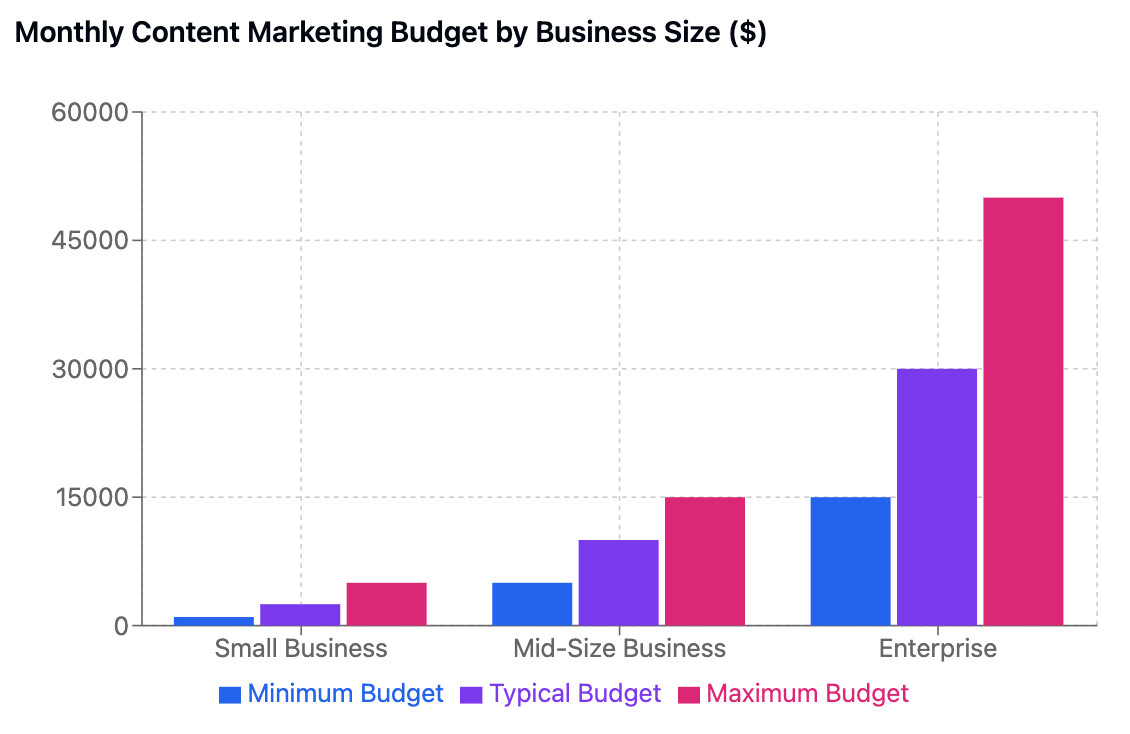
Your business size determines your content needs and budget. Let's break down what you should expect to pay for content marketing in 2025.
Small Business Content Marketing ($1,000-$5,000/month)
Small businesses need smart content strategies. A budget of $1,000 per month can get you:
-
2-4 blog posts
-
Daily social media updates
-
Basic email newsletter
-
Simple infographics
Most small businesses spend up to $2,500 monthly on content. This offers enough content for building an audience without spending a lot.
You'll get consistent blog posts, active social media, and monthly newsletters.
At $5,000 monthly, small businesses can add:
-
Weekly blog posts
-
Custom images
-
Lead magnets
-
Basic video content
Did you know? B2B Companies that got success with content marketing, spent 40% of their marketing expense, just on content marketing.
Mid-Size Business Content Marketing ($5,000-$15,000/month)
Mid-size businesses need more content across more channels. A $7,500 monthly budget typically includes:
-
8-10 blog posts
-
Daily social media content
-
Video content
-
Email campaigns
-
Case studies
-
Conversion content
The sweet spot sits at $10,000 monthly. This budget supports a full content calendar with diverse content types. You'll create enough content to dominate your niche and drive real business results.
Enterprise Content Marketing ($15,000-$50,000+/month)
Enterprise content marketing starts at $15,000 monthly. This covers:
-
Content strategy
-
Multiple content pillars
-
Custom research
-
Premium video content
-
Influencer partnerships
-
Multi-language content
Most enterprises spend $25,000-35,000 monthly on content. This budget level supports:
-
Daily blog posts
-
Premium video series
-
Custom research reports
-
Multiple newsletters
-
Social media campaigns
-
International content
Top-tier enterprise content marketing ($50,000+ monthly) includes:
-
Original research
-
Custom tools and calculators
-
High-end video production
-
Multi-market campaigns
-
Content distribution
-
Sponsored content
-
Thought leadership programs
Once you know your content marketing budget range, you’ll need to choose the pricing model. So, let’s explore more about that.
Content Marketing Pricing Models Compared
Content marketing providers use different pricing models. Each has its pros and cons.
Hourly Rate Model ($50-$250/hour)
Freelancers and small agencies often charge by the hour. Entry-level content writers charge $50-75 per hour. Mid-level writers ask for $75-150. Expert writers and strategists? They bill $150-250 per hour.
This model works best for small, one-off projects. You'll know exactly what you pay for. But costs can add up fast. A single blog post might take 3-4 hours. That's $300-600 per post at mid-level rates.
Project-Based Pricing
Most businesses prefer project-based pricing. You pay one fixed price for defined deliverables. A basic blog post package might cost $1,500 for:
-
4 blog posts
-
8 social media posts
-
Basic SEO optimization
-
2 rounds of revisions
Larger projects like content campaigns cost $5,000-15,000. These usually include strategy, creation, and distribution. You know the total cost upfront. No surprise bills.
Monthly Retainer Model
Retainers offer the best value for ongoing content needs. You pay a fixed monthly fee for a set amount of content. A standard $3,000 monthly retainer might include:
-
Content strategy updates
-
6-8 blog posts
-
Daily social media
-
Monthly newsletter
-
Basic analytics
Higher-end retainers ($5,000-10,000) add:
-
Strategy meetings
-
Premium content types
-
Distribution support
-
Performance optimization
In-House vs. Agency vs. AI Tools
In-house content teams cost $150,000-300,000 yearly. You'll need:
-
Content manager: $65,000-85,000
-
Writers: $45,000-65,000 each
-
Designer: $55,000-75,000
-
Benefits and overhead
Agencies charge $2,000-20,000 monthly. You get a full team without the overhead. But quality and communication can vary.
Modern AI writing tools cost $50-500 monthly. They help create content faster and cheaper. But you'll still need human oversight for strategy and editing.
Pro Tip: Mix And Match
Smart companies use multiple models. Try a retainer for core content. Add project-based work for campaigns. Use AI tools to speed up content creation. This flexibility helps you scale content while controlling costs.
Now, with the pricing models cleared, let’s see exactly what you’ll have to pay for each content type.
Cost Breakdown By Content Type
Different content types have different price tags. Let's look at what you'll actually pay for each type of content in 2025.
Blog Posts And Articles
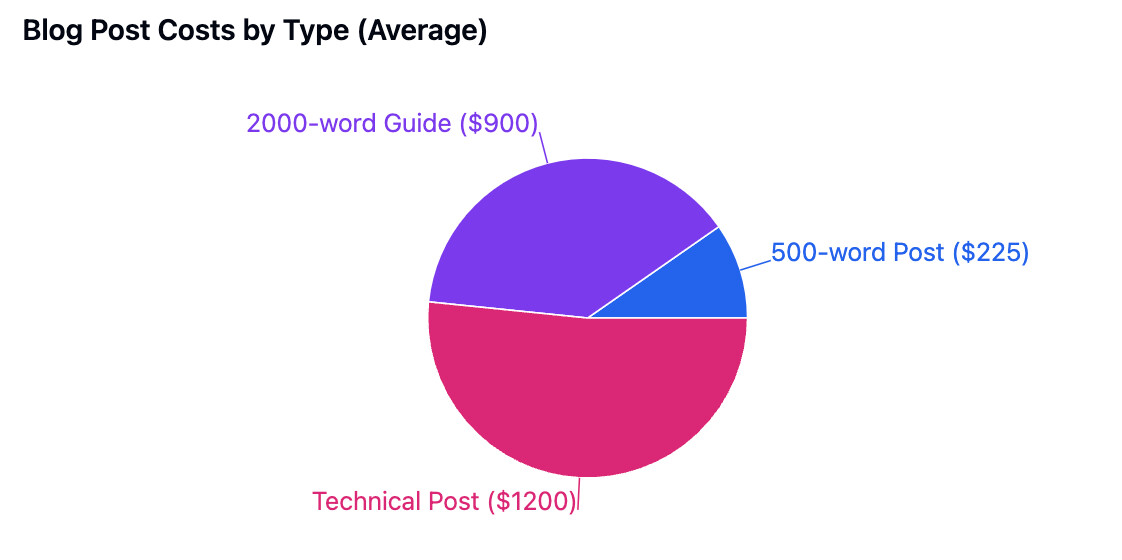
Blog post prices vary by length and complexity. A 500-word blog post costs $150-300. A detailed 2,000-word guide runs $600-1,200. Technical or data-heavy posts cost more.
Quality affects price too. Budget content costs $0.10 per word. Premium content from expert writers costs $0.30-0.50 per word. Most businesses need 4-8 blog posts monthly. That's $1,200-4,800 for blog content alone.
Social Media Content
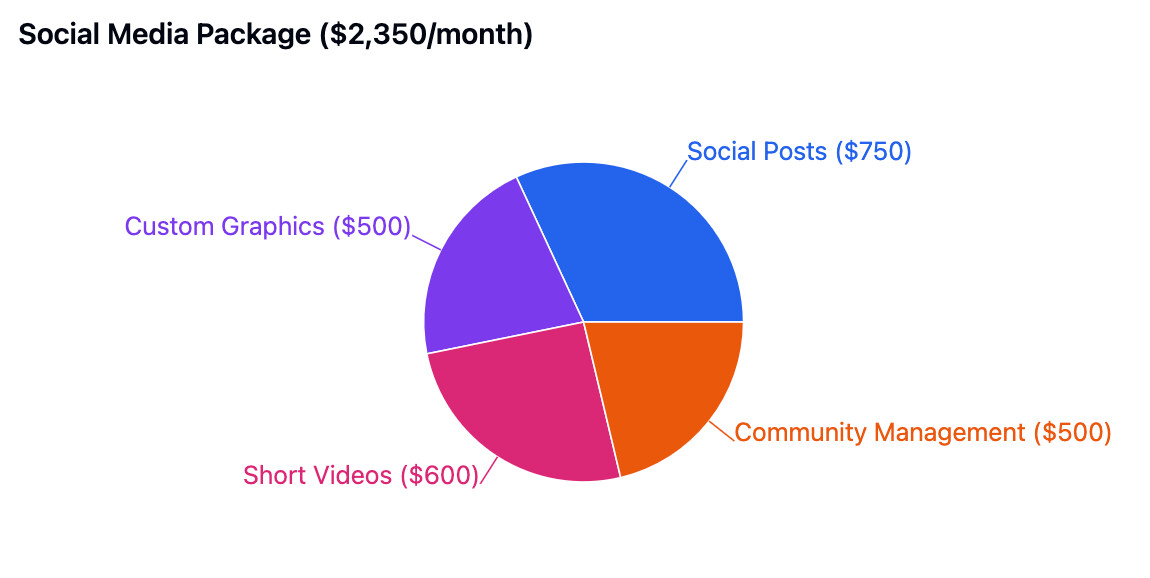
Social media packages start at $1,000 monthly. This covers daily posts on 2-3 platforms. Want custom graphics? Add $500-1,000. Video content adds another $1,000-2,000.
A standard social package includes:
-
30 social posts: $750
-
10 custom graphics: $500
-
2 short videos: $600
-
Community management: $500
-
Total: $2,350 monthly
Video Content
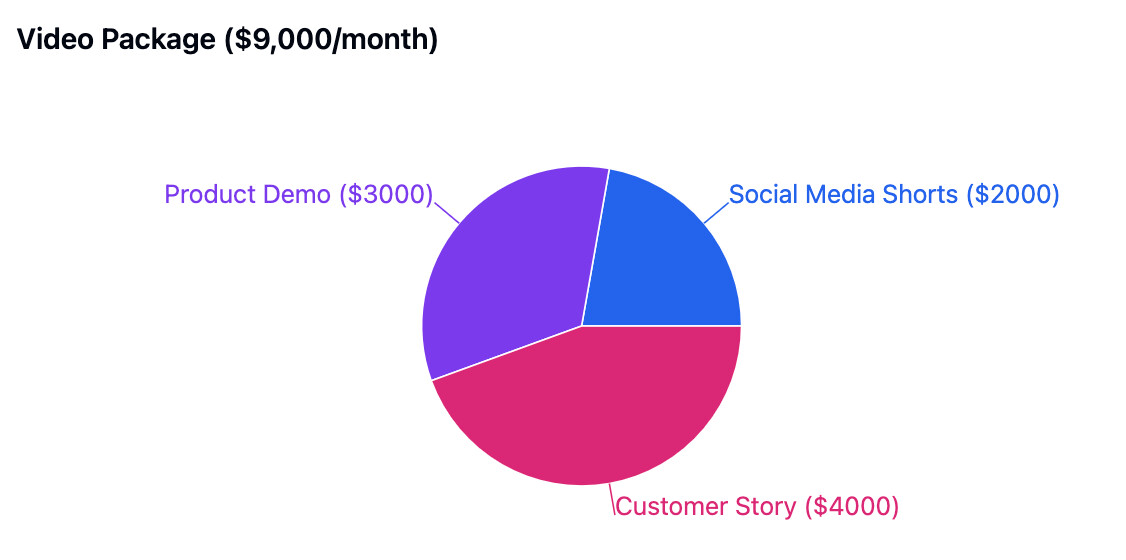
Video costs add up fast. A basic 2-minute explainer video costs $1,500-3,000. Professional videos with actors and effects? $5,000-10,000 per minute.
Monthly video packages include:
-
4 social media shorts: $2,000
-
1 product demo: $3,000
-
1 customer story: $4,000 Total: $9,000 monthly
Email Newsletters
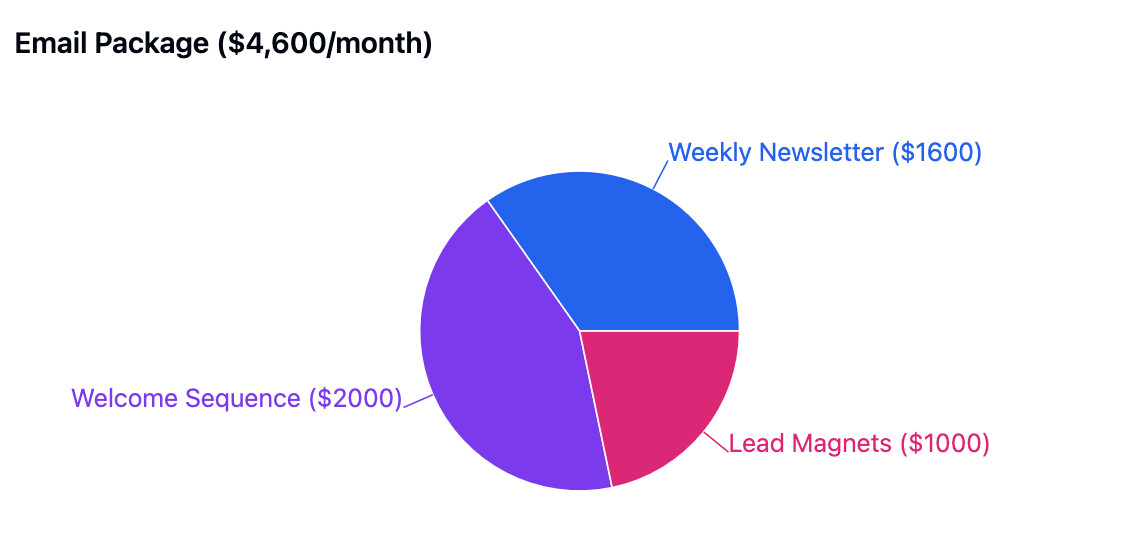
Email marketing costs depend on complexity. Basic newsletters cost $300-500 each. Premium newsletters with custom design run $800-1,500.
A typical email program includes:
-
Weekly newsletter: $1,600
-
Welcome sequence: $2,000
-
Lead magnets: $1,000 Monthly total: $4,600
Ebooks And Research Papers
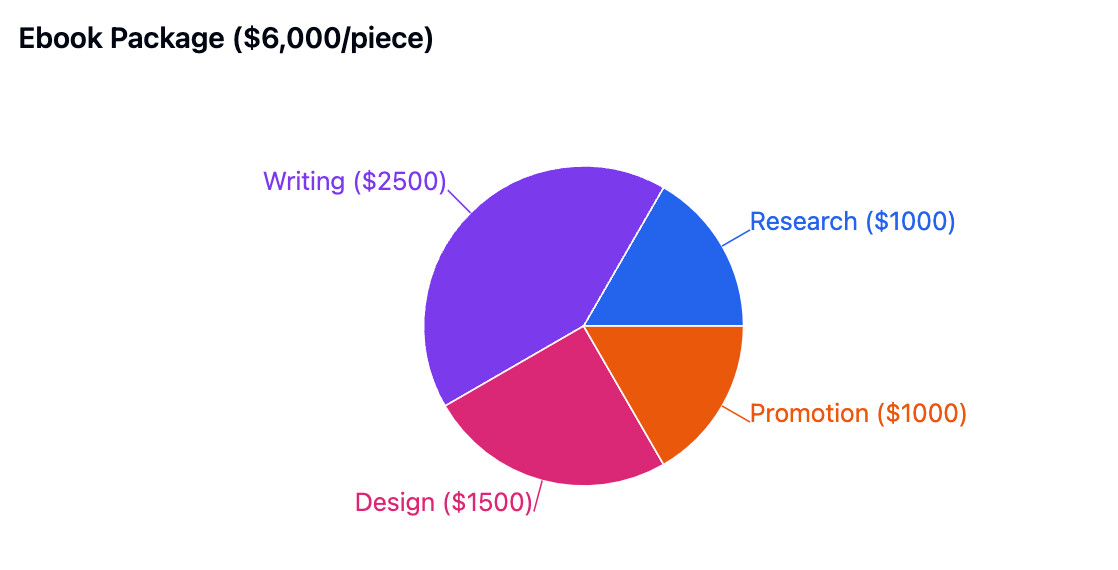
Long-form content costs more but drives leads. A basic 15-page ebook costs $2,000-3,500. Research papers run $3,000-7,000.
The full package includes:
-
Research: $1,000
-
Writing: $2,500
-
Design: $1,500
-
Promotion: $1,000 Total: $6,000 per piece
Pro Tip: Content Bundles
Many providers offer content bundles at 20-30% off individual prices. A typical bundle might include:
-
4 blog posts
-
20 social posts
-
1 newsletter
-
2 videos Regular price: $5,000 Bundle price: $3,750
Now, those are the main costs you can expect. But watch out—some expenses can often go unnoticed.
Costs In Content Marketing That Often Go Unnoticed
Most businesses focus on content creation costs. But there are some expenses that can eat up 30-50% of your budget, and they often go unnoticed. Let's learn more about these costs so you can plan better.
Software And Tools
Your content team needs tools to work. A basic content marketing stack costs $200-500 monthly. Here's what you'll need:
Content Management System (CMS): $30-300 monthly. WordPress costs less but needs more setup. HubSpot costs more but includes more features.
SEO Tools cost $100-300 monthly. You need them to research topics and track rankings. Most teams use Ahrefs ($199) or Semrush ($119-229).
Design tools add another $50-100 monthly. Canva Pro costs $30 per user. Adobe Creative Cloud runs $80 per user.
Content Distribution
Free social media posting won't cut it anymore. You need paid distribution. Most businesses spend $500-2,000 monthly on:
-
Social media ads: $300-1,000
-
Newsletter platform: $50-500
-
Content Repurposing and sharing: $300-1,000
-
Influencer partnerships: $500-2,000
Content Updates And Maintenance
Old content needs updates. Plan to spend 15-20% of your budget on maintenance. A typical update schedule costs $1,000-2,000 monthly:
-
Blog updates: $400-800
-
Fact-checking: $200-400
-
Content audits: $500-1,000
Team Training And Development
Your team needs to stay current. Training costs include:
-
Courses and certifications: $2,000-5,000 yearly
-
Industry conferences: $3,000-6,000 yearly
-
Team workshops: $1,000-3,000 yearly
Quality Control And Editing
Good content needs multiple eyes. Editing services cost:
-
Copy editing: $0.02-0.05 per word
-
Proofreading: $0.01-0.03 per word
-
Fact-checking: $40-60 per hour
A typical blog post needs $100-200 in editing. That's $800-1,600 monthly for 8 posts.
Pro Money-Saving Tip
Use AI tools to cut these hidden costs. Modern AI platforms combine many tools into one subscription. This can save 40-60% on software costs. Plus, they speed up content creation and reduce editing needs.
Want to cut down these unnoticed costs in content marketing without losing content quality? Here’s how you can do it.
How To Reduce Content Marketing Costs (Without Affecting Quality)
Content marketing doesn't need to drain your budget. Smart businesses use modern tools like SEOWriting to cut costs by half while maintaining quality. Here's how you can do the same.
SEOWriting helps you create SEO-optimized content in minutes instead of hours. The platform includes several features like:
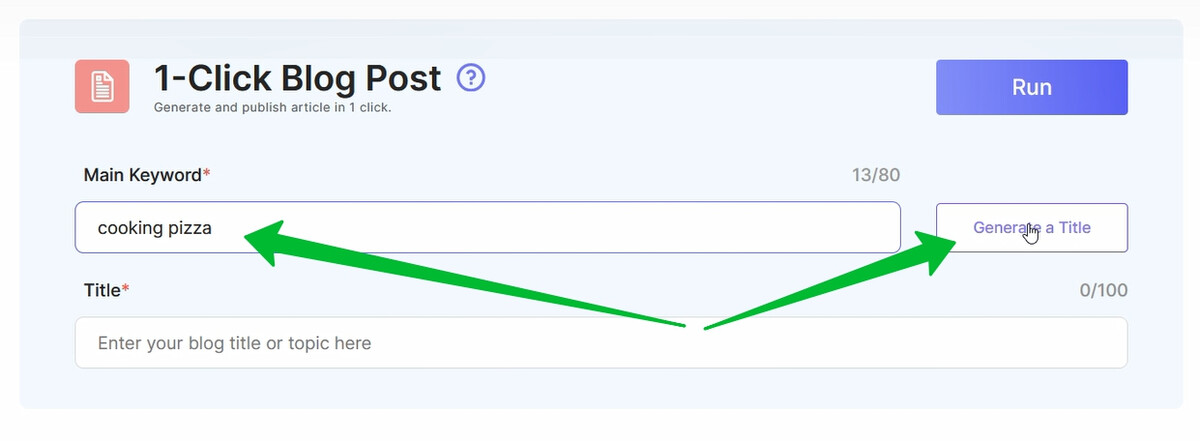
One-Click Blog Posts: Create complete, SEO-ready articles instantly. This cuts writing costs from $300 per post to just $19 per month for up to 50 posts.

Auto Internal Linking: The system automatically adds relevant internal links. This saves 2-3 hours of manual work per post.
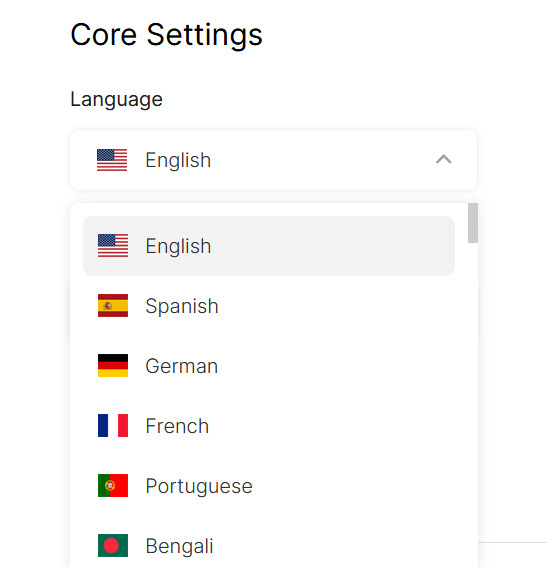
Multi-Language Support: Create content in 48 languages without hiring translators. This saves $0.15-0.25 per word in translation costs.
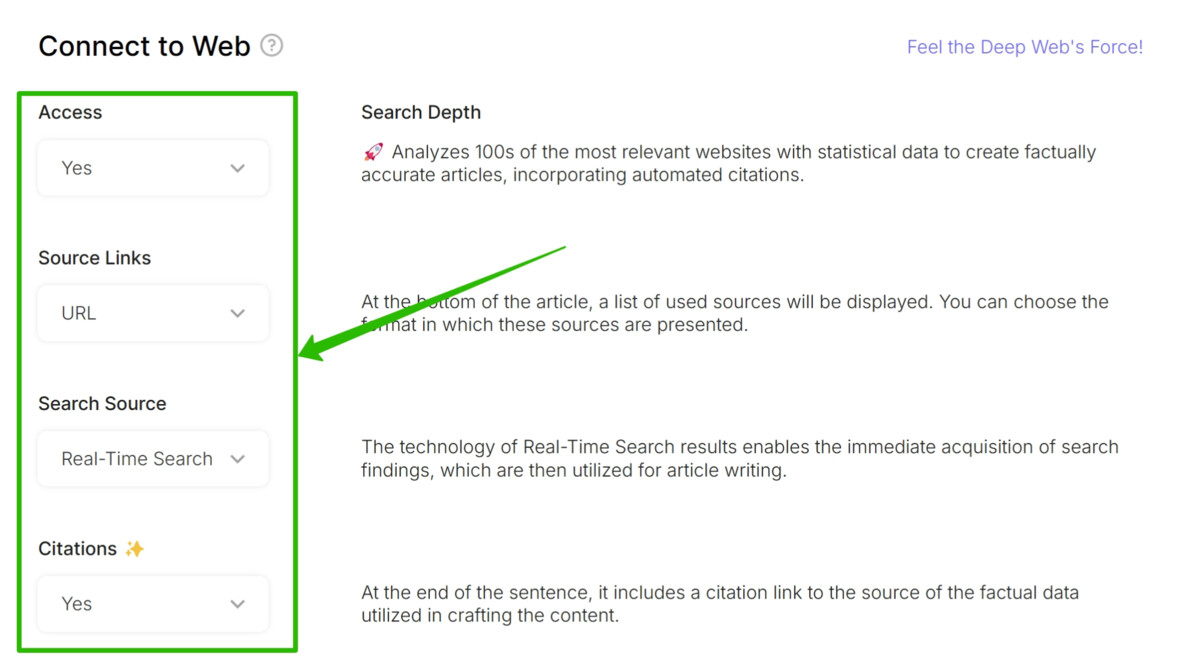
Research Time: Built-in deep web integration finds relevant data automatically. This cuts research time significantly.
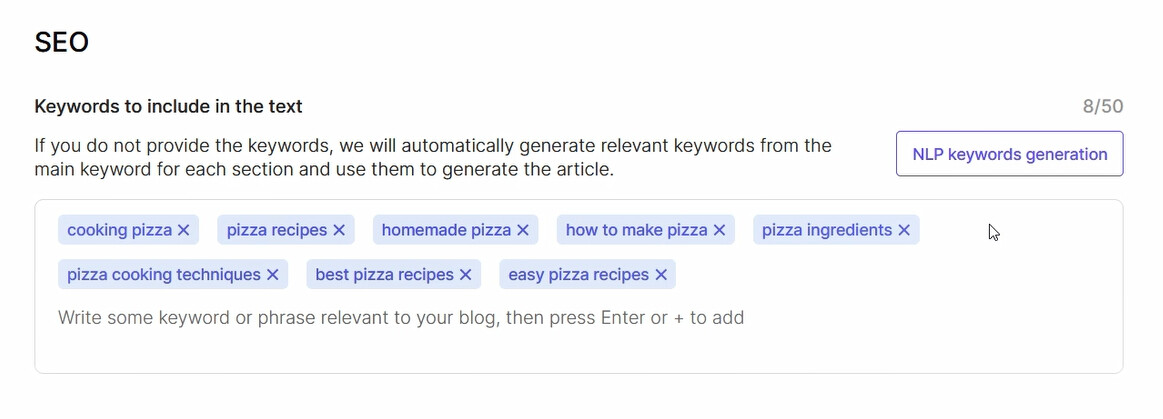
SEO Optimization: NLP keywords and auto-optimization save $200-400 per post in SEO consultant fees.
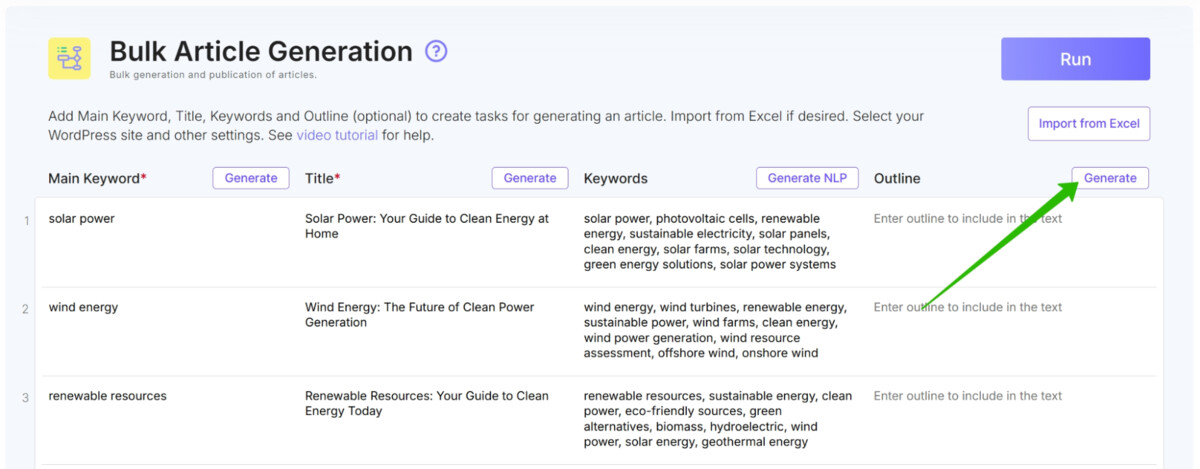
Bulk content creation leads to big savings too. With SEOWriting's bulk features, you can:
-
Create multiple blog posts in the time it usually takes to write just one post.
-
Generate consistent brand voice across all content.
-
Maintain quality with AI-powered readability enhancement.
Quality matters more than quantity. SEOWriting helps optimize your content:
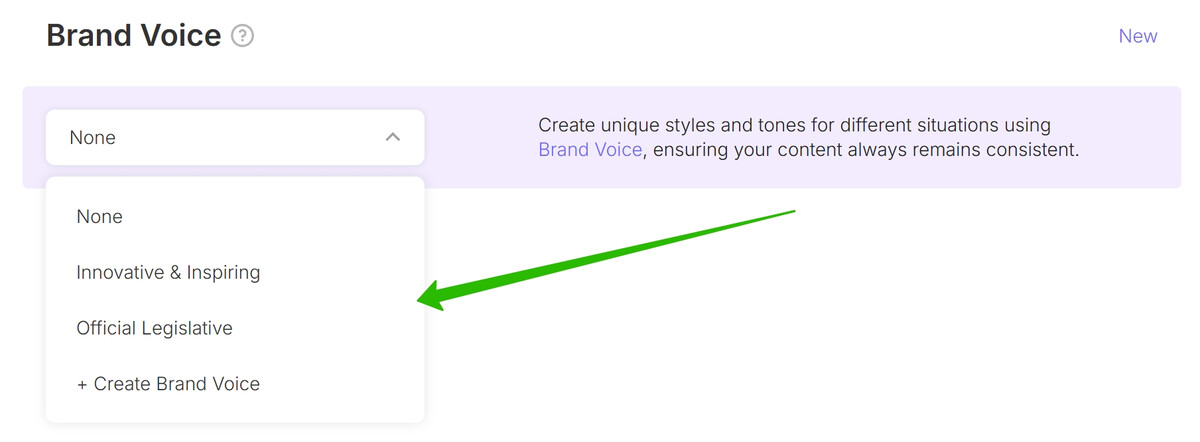
Brand Voice Customizer: Maintain consistent tone without expensive style guides
With SEOWriting, you can get better content in less time at a fraction of the cost.
Now saving costs is great for any business. But you need results too. So, now let’s explore more about the ROI of content marketing and how you can calculate it.
How To Calculate The ROI of Content Marketing?
Content marketing ROI matters. You need to prove your investment works. The average content marketing ROI ranges from 300% to 600%. Let's break down how to calculate yours.
Basic ROI Formula
The simple formula looks like this: ROI = (Revenue from Content - Content Cost) / Content Cost x 100
A real example: You spend $5,000 on content. It generates $20,000 in sales. ROI = ($20,000 - $5,000) / $5,000 x 100 = 300%
Track These Revenue Metrics
You need to connect content to money. Set up tracking for:
-
Direct Sales: People who read your content and buy. The average blog post generates $700 in direct sales over 12 months.
-
Lead Value: Each lead from content is worth money. A B2B lead typically values $100-200. Multiply this by your conversion rate.
-
Organic Traffic Value: Calculate what you'd pay for the same traffic from ads. SEO traffic costs $3-7 per click on average.
Calculate All Content Costs
Add up everything you spend:
-
Content creation: $2,000 monthly
-
Tools and software: $500 monthly
-
Distribution: $1,000 monthly
-
Team time: $1,500 monthly
-
Total: $5,000 monthly
Measure Long-Term Value
Content keeps working. A good blog post brings value for years:
-
Year 1: 100% of value
-
Year 2: 80% of value
-
Year 3: 50% of value Total value over 3 years: 230% of first-year value
ROI Example
Let's look at an example:
Monthly Investment:
-
Content costs: $5,000
Monthly Returns:
-
Direct sales: $8,000
-
Lead value: $4,000
-
SEO traffic value: $3,000
-
Total return: $15,000
Monthly ROI: 200% Yearly ROI: 400% (including compound effects)
Did you know? Over 7 in 10 successful marketers actively measure the ROI of their content marketing efforts.
Pro ROI Tracking Tip
Track micro-conversions too:
-
Email signups: Worth $10 each
-
Social shares: Worth $5 each
-
Comments: Worth $3 each
These small wins add up to 15-25% more ROI.
Now that you know about the ROI of content marketing, let’s see how you can build your content marketing budget.
How To Plan Your Content Marketing Budget?
Your content marketing budget needs a solid plan. Most businesses spend 7-12% of revenue on content marketing. Let's break down how to plan yours effectively.
Start With Your Goals
Set clear targets first. Want 10,000 monthly visitors? Plan for 20-30 blog posts. Need 50 leads monthly? Budget for premium content like ebooks. Different goals need different budgets.
A typical small business goal might be:
-
25% traffic growth
-
100 new leads
-
10 sales from content
This needs about $3,000 monthly.
Map Out Essential Costs
Your base budget needs these items:
Content Creation Core: Allocate 40% here. For a $5,000 monthly budget, that's $2,000 for content creation. This covers about 6-8 blog posts or 2-3 premium pieces.
Distribution Budget: Set aside 30%. That's $1,500 for social media, email, and paid promotion. You need eyeballs on your content.
Tools and Software: Reserve 20%. About $1,000 for SEO tools, analytics, and content platforms. Good tools save money long-term.
Plan for Growth
Add 10-15% extra for opportunities. Market changes fast. You might need:
-
Trending topic coverage
-
New content types
-
Platform experiments
-
Viral opportunity budget
Use the 70/20/10 Rule
Split your content budget:
-
70% on proven content types
-
20% on growing channels
-
10% on new tests
Final Thoughts
Content marketing costs vary widely. You might spend $1,500 or $15,000 monthly based on your needs. The key is to match your budget to your goals. Small businesses can start with basic blog posts and social media. Larger companies need diverse content types and distribution channels. Either way, content marketing delivers strong ROI when done right.
Remember these key strategies: Start with clear goals. Track your ROI from day one. Use the 70/20/10 rule for budget allocation. Mix different content types to maximize impact. Most importantly, focus on quality over quantity. One great piece of content outperforms ten mediocre ones. Smart businesses also use modern tools to cut costs while maintaining quality.
Ready to create high-quality SEO-optimized blog posts? Try SEOWriting for Free!
FAQs
1. How Much Should A Small Business Spend On Content Marketing?
Small businesses should invest 5-10% of revenue in content marketing. For a business making $500,000 yearly, that's $25,000-50,000 annual content budget. Start with $2,000-3,000 monthly and scale up based on results.
2. What's The Minimum Effective Content Marketing Budget?
A minimum effective budget starts at $1,500 monthly. This covers basic blog content, social media, and essential tools. Use AI tools like SEOWriting to stretch this budget further.
3. Should I Hire In-House Or Use Agencies?
For budgets under $5,000 monthly, use freelancers or AI tools. Between $5,000-15,000, consider agencies. Above $15,000, build an in-house team. Most businesses mix these approaches based on needs.
4. How Long Until I See ROI From Content Marketing?
Expect first results in 3-6 months. Full ROI usually takes 6-12 months. High-quality content keeps working for years, delivering 300-600% ROI over time.
5. What Should I Cut First If My Budget Shrinks?
Start with experimental content (10% of budget). Then reduce paid promotion (30% of budget). Keep your core content creation budget. Quality matters more than quantity.
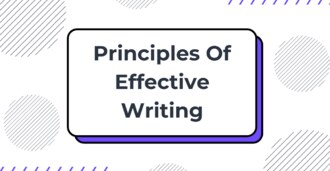


Write 10X Faster With AI-Powered Content
Create SEO-optimized articles in 15 minutes instead of 5 hours. Join 50,000+ content creators who generate content that ranks on top positions on Google. Save up to 80% of your time while getting 2X better results.
Try for Free →
